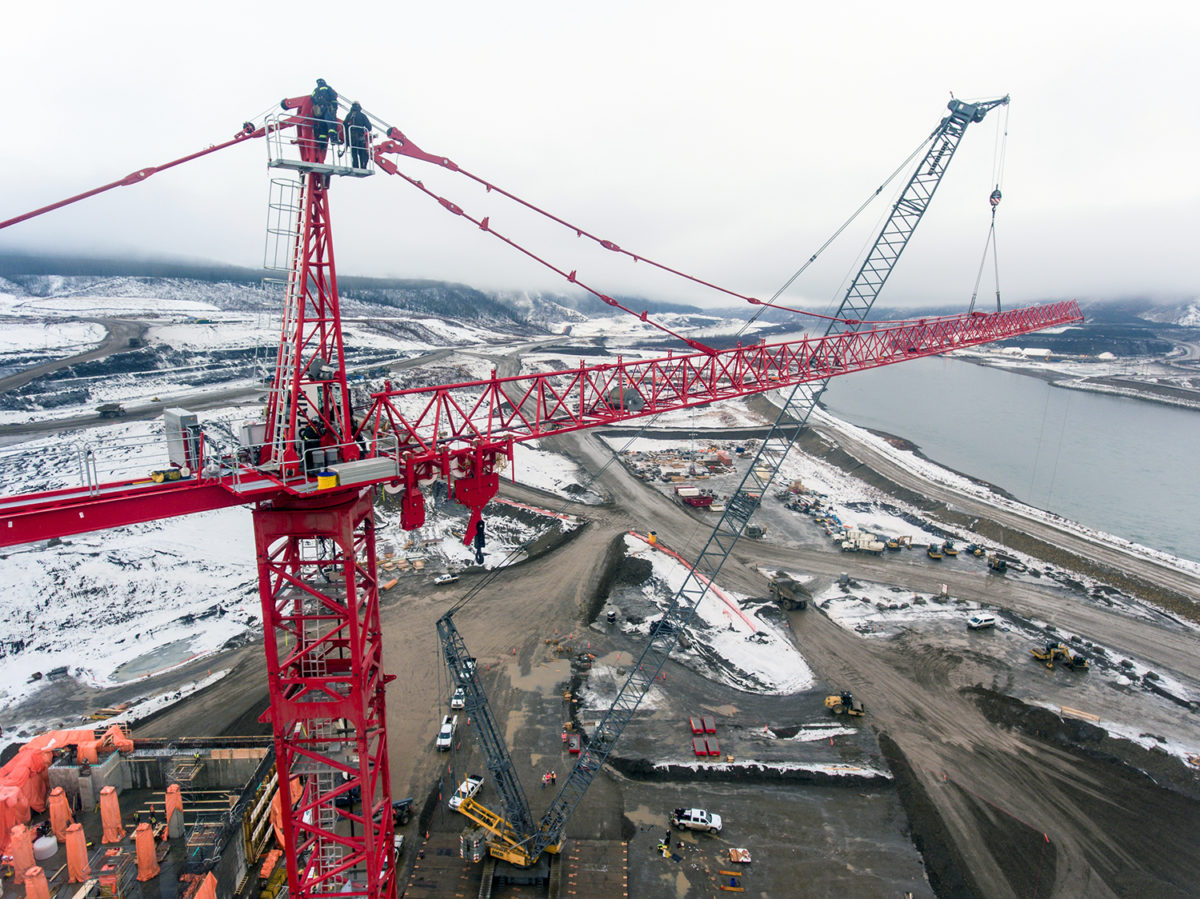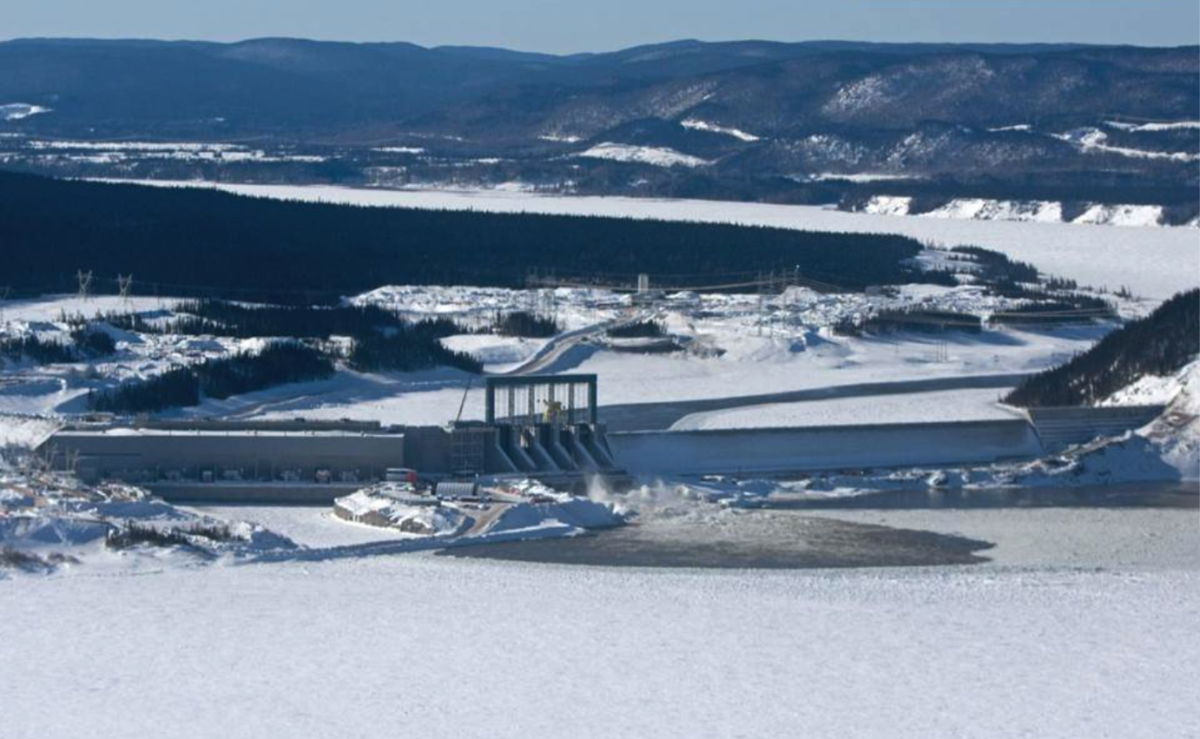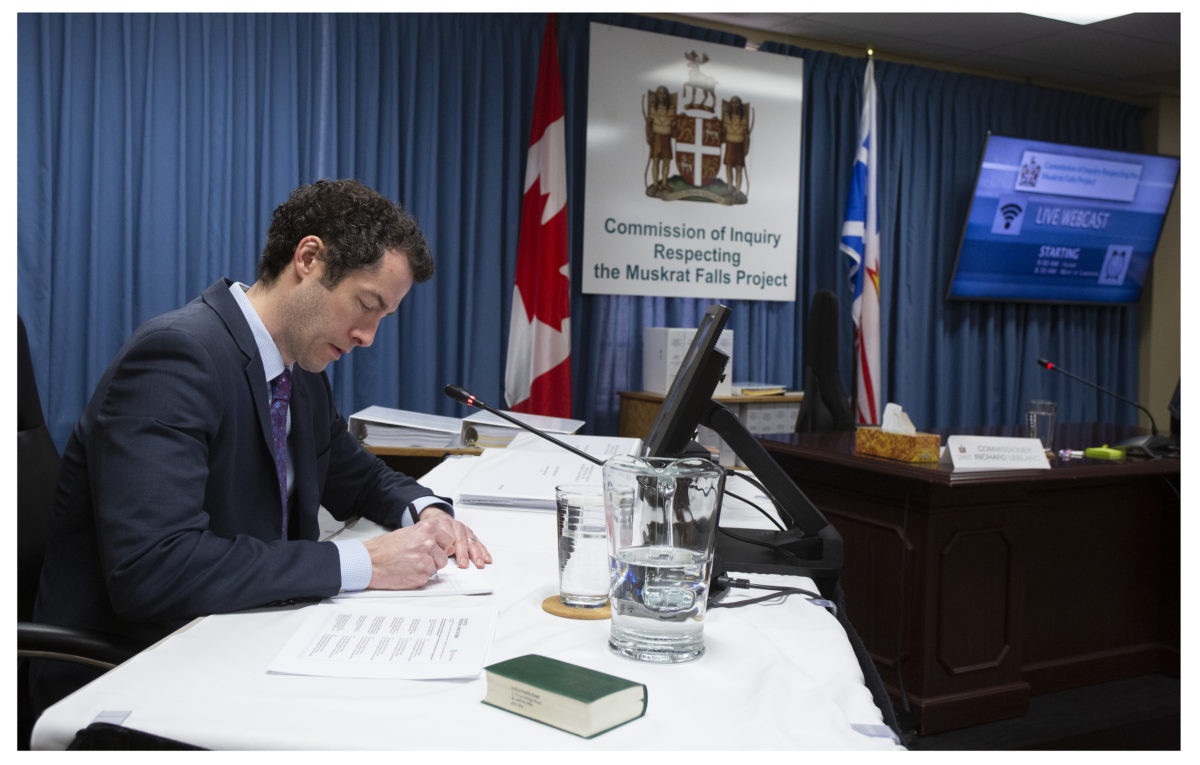
In a Nova Scotia research lab, the last hope for an ancient fish species
Racing against time, dwindling habitat and warming waters, scientists are trying to give this little-known...
This is part three of a three-part, reader-funded series on the Muskrat Falls dam inquiry.
The Muskrat Falls dam in Labrador and the Site C dam in B.C. are on opposite sides of the country yet share some startling similarities. Both projects are being built with public money and both are billions of dollars over-budget.
In Newfoundland and Labrador, a two-year inquiry is underway to find out why the province’s energy corporation, Nalcor, continued full-steam ahead with the Muskrat Falls dam on the lower Churchill River despite early warning signs that the project was uneconomical.
The Muskrat Falls price tag — originally set at $6.2 billion — has now jumped to $12.7 billion. Newfoundlanders are bracing themselves for at least 50 per cent hydro rate increases when full power from the dam comes on-line next year.
In B.C., the contentious Site C dam on B.C.’s Peace River is tentatively scheduled for completion in 2024.
The Site C dam’s $10.7 billion tab — up from $6.6 billion when the project was announced in 2010 — will come due only when the power comes on-line.
With so much at stake in B.C., The Narwhal is keeping tabs on the Muskrat Falls dam inquiry, which is hearing testimony from everyone from politicians and senior bureaucrats to SNC-Lavalin executives and Nalcor officials.
Here are nine things B.C. can learn from Newfoundland’s Muskrat Falls mistakes.
The inquiry has revealed that Newfoundland politicians failed to rein in Nalcor, the publicly owned energy corporation that pushed the project forward despite internal knowledge of rising costs and increased project risks.
One government lawyer interviewed by inquiry co-counsels called Nalcor a “fiefdom” and a “runaway train.” In testimony at the inquiry, he said Nalcor “jealousy guarded access to its information.”
A number of Newfoundland politicians have testified that they trusted the information they received from top officials at Nalcor, leading inquiry co-counsel Barry Learmonth to call the politicians “naïve” and “blindly accepting” of Nalcor’s work.
“Government was simply accepting whatever Nalcor told you, with very little review. And I suggest to you that was a very risky decision to make.”
Newfoundland consumer advocate Dennis Browne told the inquiry last month that Nalcor received a “blank cheque” from the provincial treasury to build the boondoggle dam and its transmission lines.
Soaring costs for the Site C dam indicate that BC Hydro also has a blank cheque for the project.
Site C’s price tag had already risen to $7.9 billion by the time the project was examined by a federal-provincial panel.
Following that review, the price tag climbed by almost another billion dollars — to $8.8 billion — when former Premier Christy Clark granted final approval to the project in December 2014.
The independent B.C. Utilities Commission conducted a fast-tracked review in the fall of 2017 based on that price tag.
But only weeks after the commission delivered its final report, BC Hydro revealed that the dam’s cost had skyrocketed by almost another $2 billion, to $10.7 billion.
Despite having access to outdated budget information, the independent review concluded that the Site C dam’s final tab could exceed $12.5 billion.
“Who would build a house without asking the contractor, ‘What are the upper limits of the cost of this?’ ” Browne told media following his testimony. “No one out there who is reasonable would conduct themselves in such a fashion. But our government did.”

A tower crane is assembled on the south bank of the Peace River amid ongoing construction of the Site C dam in November 2018. Photo: BC Hydro
Newfoundland’s Conservative government stripped
the province’s public utilities board from deciding if the Muskrat Falls dam was in the public interest. The board was eventually asked to review the project, but it was given such limited terms of reference and outdated information from Nalcor that it said it was unable to reach any conclusions.
In B.C., much the same scenario unfolded. Determined to build the Site C dam, B.C.’s former Liberal government changed the law to remove the independent B.C. Utilities Commission (BCUC) from examining the project to determine if it was in the public interest.
The commission finally reviewed the Site C dam in the fall of 2017 but with limited terms of reference from a new NDP government and no power to recommend whether or not the project should go ahead. The commission was also given Site C dam budget information for its review that, just weeks later, was replaced by new numbers adding up to billions of dollars more for the final cost.
Normally the commission would have the power to scrutinize BC Hydro’s quarterly reports about Site C and to ask questions or for supporting documentation.
So far the NDP government has chosen not to reinstate the commission’s watchdog role in monitoring the Site C dam. BC Hydro files quarterly Site C reports to the commission, but it has no power to ask questions about the reports or to request supporting documentation.
Instead, the NDP government has set up a secretive Site C “project assurance board” whose members include six BC Hydro directors and a consultant who was commissioned by B.C.’s construction trade unions to write a report favourable to the project.
The findings of the “project assurance board” are not available to B.C. ratepayers who are paying for the Site C dam.
The Muskrat Falls inquiry led to an announcement from the Newfoundland government that it is restoring the “appropriate” role of the independent utilities board in providing project oversight.

The Muskrat Falls dam under construction in February 2019. Photo: Nalcor
Just as Nalcor planned for decades to construct the Muskrat Falls dam, BC Hydro planned for decades to construct the Site C dam.
Clark touted the Site C dam as a legacy project in keeping with a vision championed by populist premier W.A.C. Bennett, who constructed his namesake dam on the Peace River in the 1960s.
In Newfoundland, former Premier Danny Williams aimed to follow in the footsteps of legendary Premier Joey Smallwood, who constructed the behemoth Churchill Falls dam on its namesake river in the 1960s. (The dam became operational in 1971.)
But just because large hydro projects made economic sense in the 1960s and 1970s doesn’t mean they are viable now. The global energy market has shifted dramatically in the past decade and Canada’s publicly owned energy corporations haven’t kept up with the trends, according to energy experts.
Muskrat Falls energy will be sold to the U.S. for a pittance of what it costs to produce the power.
Site C’s hugely expensive power — destined for the U.S. spot market and B.C.’s already heavily subsidized LNG industry — will also never be sold for close to what it will cost to produce.
At $10.7 billion, the Site C dam is uneconomical, according to a 2019 report from the C.D. Howe Institute, which says it is in the best interests of BC ratepayers to cancel construction immediately. (In an email to The Narwhal, the B.C. energy ministry dismissed the report as “fundamentally flawed.”)
Power from uneconomical dams can’t be sold for what it costs to produce, leaving unsuspecting ratepayers to make up the difference.
The Muskrat Falls dam inquiry has highlighted opportunities when politicians could have stopped construction of the dam as costs rose and risks heightened.
The cash-strapped government of Newfoundland and Labrador can’t afford to bail out Nalcor.
So it has to turn to the federal government for a Muskrat Falls bailout. That means federal taxpayers will help pay for the troubled project.
Like Nalcor, BC Hydro is deeply in debt. The B.C. government — which is in a far better financial position than the Newfoundland government — recently bailed out BC Hydro for $1.1 billion.
But the public utility is still $4.4 billion in the red even before the unsightly tab for the Site C dam comes due.
More taxpayer bailouts for BC Hydro are almost certain.
In December 2017, when explaining his decision to greenlight the Site C dam, Horgan warned that a BC Hydro bail out could lead to cuts to services and compromise the government’s ability to build schools and hospitals.
Newfoundland politicians, senior bureaucrats and Nalcor officials are all in the hot seat at the Muskrat Falls inquiry, which seeks to determine who was responsible for moving the boondoggle project forward.
The inquiry’s final report, due by the end of the year, is expected to point fingers. That could lead to charges against politicians and senior civil servants, as well as disciplinary hearings for members of professional organizations such as engineers and accountants.

James Meaney of Nalcor Energy prepares to take the stand at the Muskrat Falls Public Inquiry in St. John’s, N.L., on March 26, 2019. Photo: Paul Daly / The Narwhal
Like the Site C dam, the Muskrat Falls project was shrouded in secrecy until a public outcry forced an inquiry.
People like David Vardy, the retired chair of Newfoundland’s public utilities board, tried to get detailed information about the Muskrat Falls dam for years through access to information requests, often coming up empty-handed or with critical pages redacted. All the while, the Newfoundland government assured the public that everything was fine.
Now the previously secret reports are part of the inquiry testimony, available to the public. They paint a disturbing picture of a Crown corporation so determined to push forward with dam building that it withheld pertinent information from decision-makers, according to evidence presented at the inquiry.
The veil of secrecy surrounding the Site C dam was briefly lifted by the fast-tracked B.C. Utilities Commission review. But since then detailed information about the project’s cost, schedule and geotechnical problems have been kept secret.
The embattled global engineering firm SNC-Lavalin was involved in cost estimates for both the Site C and Muskrat Falls dams.
In the fall of 2012, as questions about SNC-Lavalin’s global business practices made headlines, a new CEO came on board to steer the corporate ship away from the shoals.
Bob Card, an American engineering veteran who had served as the U.S. energy ministry undersecretary, replaced SNC-Lavalin CEO Pierre Duhaime, who had been arrested on fraud charges.
Card was tasked with putting a plan in place to show the World Bank, which had assigned a full-time monitor to SNC Lavalin, that “SNC was putting everything in place to avoid [being] caught in any future issue,” according to inquiry testimony from Normand Béchard, the Muskrat Falls project manager for SNC-Lavalin. That included reviewing and amending policies, and ensuring compliance, Béchard said.
Card brought best management practices with him, according to Béchard. And one of those best practices was to assess risks on large projects in which SNC was involved, in order “to better control the exposure of the company.” From then on, every big project would need to have a SNC-Lavalin corporate risk assessment, Béchard told the inquiry.
Béchard was tasked with the Muskrat Falls corporate risk assessment, a job he said took up to a month and a half to complete.
His risk assessment pegged the financial risk for the Muskrat Falls dam at $2.4 billion higher than Nalcor’s budget for the project.
Whether or not Nalcor ever saw the SNC-Lavalin report is a matter of dispute.
Jean-Daniel Tremblay, director of risk assessment services at SNC-Lavalin, recently testified at the inquiry that it was his understanding that Nalcor had seen the report but that the report needed “to not exist” because it could have been made public through an access to information request. (Former Nalcor CEO Ed Martin has said he never saw the report.)
Béchard’s testimony suggests that somewhere — as costs soar for the Site C dam — there may be a SNC-Lavalin internal risk assessment report that could provide valuable information about risks and related additional costs.
BC Hydro told The Narwhal it is not aware of any SNC-Lavalin internal risk assessment report for the Site C dam. SNC-Lavalin did not respond to a request for a brief interview.
The public outcry about the Muskrat Falls dam began when Newfoundland ratepayers realized their hydro rates were poised to soar to pay for the project.
B.C. ratepayers are already facing new hydro rate increases of at least eight per cent over the next five years even before they start paying for the Site C dam in 2024.
With almost no scrutiny from most of B.C.’s media, the Site C dam continues to fly beneath the public radar — for now.
Get the inside scoop on The Narwhal’s environment and climate reporting by signing up for our free newsletter. On March 17, federal Conservative Leader Pierre Poilievre...
Continue reading
Racing against time, dwindling habitat and warming waters, scientists are trying to give this little-known...

From investigative reporting to stunning photography, we’ve been recognized with four 2024 CAJ Awards nods...

The Narwhal is expanding its reach on video platforms like YouTube and TikTok. First up?...
